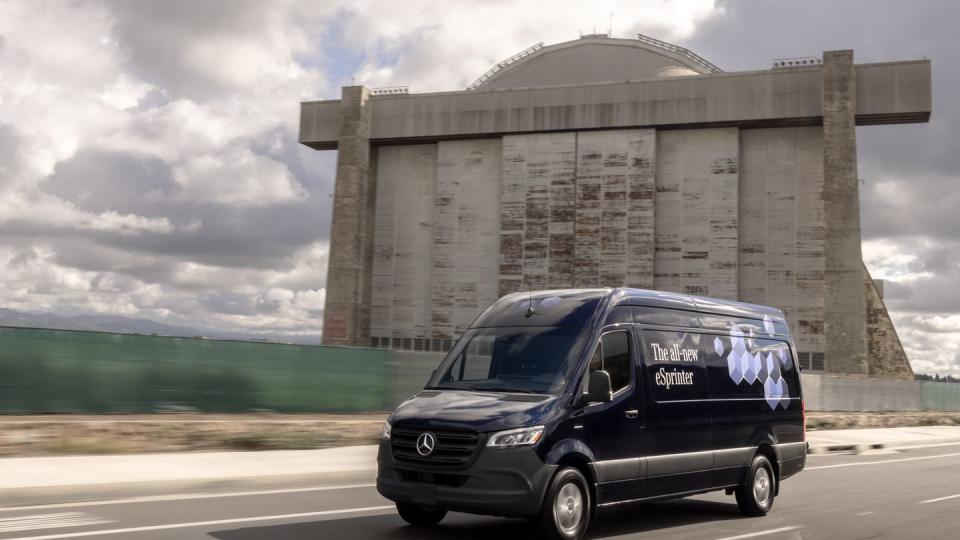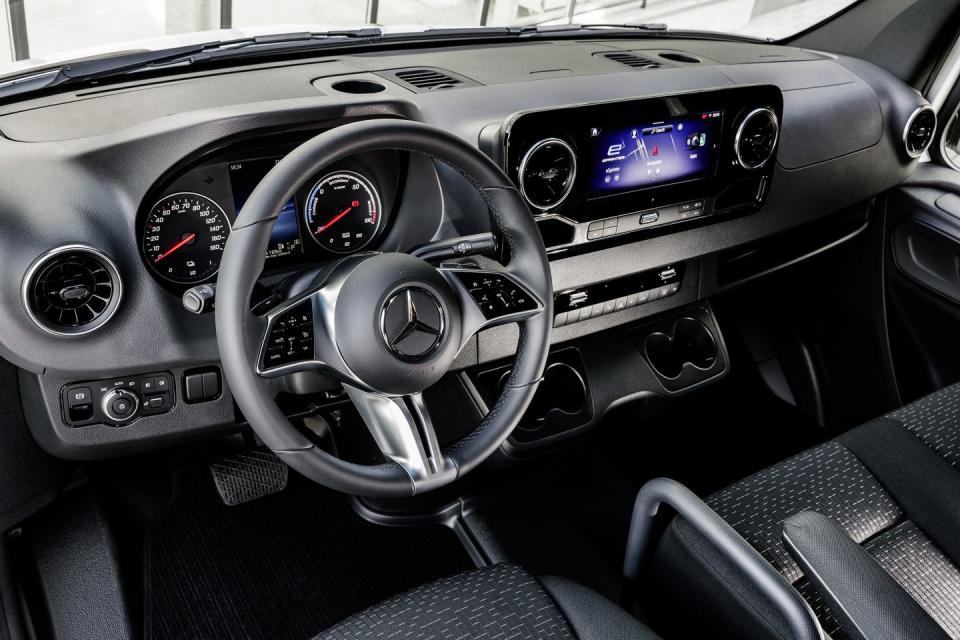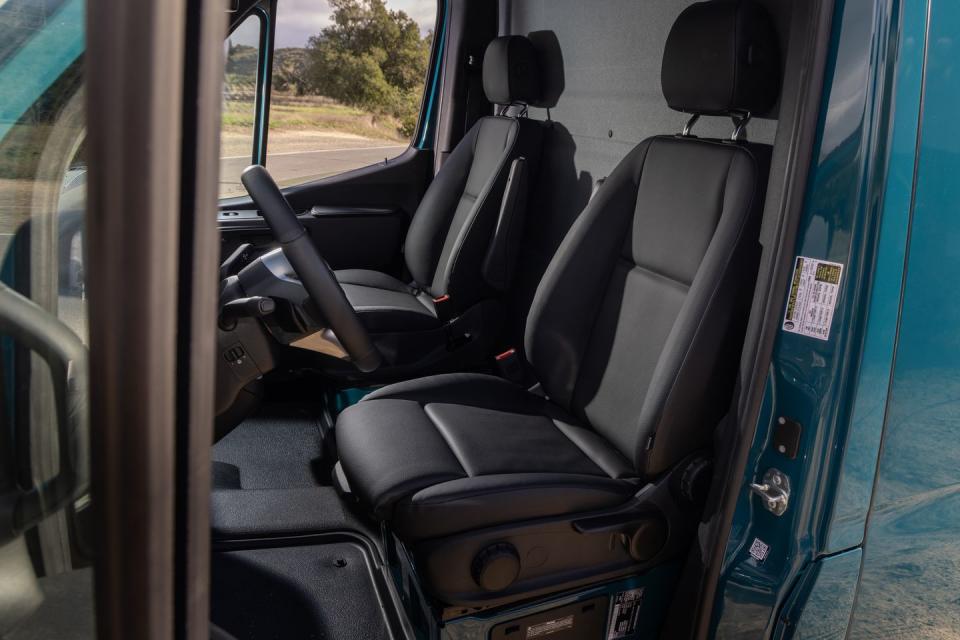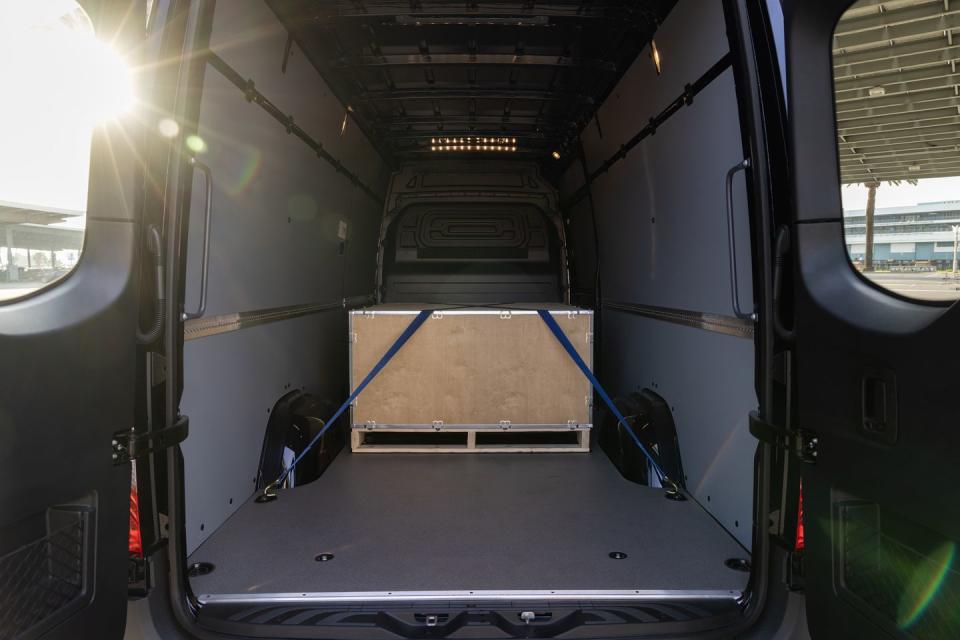2024 Mercedes-Benz eSprinter Paves the Way for Future Deliveries

Mercedes-Benz's march toward electrification contains multitudes. On one end of the spectrum we have the EQS SUV, an egglike craft adorned with ambient lighting and wall-to-wall screens full of crisply rendered graphics. And all the way over on the other side is the 2024 Mercedes-Benz eSprinter. The electric variant of the long-running Sprinter commercial van eschews the EQS SUV's fripperies, but its quiet, smooth, and responsive operation—not to mention this latest version's much-improved range and efficiency—demonstrates why electric vans will proliferate in the coming decade.
Mercedes launched the Europe-market electric Sprinter in December 2019, but its meager range barely eclipsed 100 miles under the right conditions, making it a difficult proposition for North America. This second-generation eSprinter, however, is ready to go the distance in the U.S., starting with a single configuration—a high-roof body with a 170.0-inch wheelbase and a 280.4-inch overall length.

Packing a 113.0-kWh lithium-iron-phosphate battery, the eSprinter should have a range of 273 miles on the optimistic European WLTP test cycle, with an impressive 329-mile estimate on the WLTP city-specific cycle. Stateside measures tend to be far lower, but we believe it should get around 230 miles of EPA range. On our drive, the eSprinter's dashboard readout displayed 181 miles of range at the start. A two-hour, 69-mile drive loop that included hilly terrain and highway driving dropped that to 129 miles, with a claimed efficiency of 2.0 miles per kWh, which would align with our top-tier guesswork.
Given the van's size and heft (curb weight is a C/D-estimated 6900 pounds), 200-plus miles seems adequate for the eSprinter's intended function of local deliveries. A standard heat pump helps mitigate cold-weather efficiency issues, and Eco and Maximum Range drive settings improve range by limiting power, although we can't imagine many drivers will want to downgrade to the latter's lethargic 107-hp output cap. When it's time to recharge, the eSprinter handles up to 115 kW on a DC fast-charger, with the battery going from 10 to 80 percent in a claimed 42 minutes. The maximum Level 2 charging speed is 9.6 kW.

The eSprinter's rear-mounted electric motor comes in two differing outputs. The 134-hp version costs $3430 less than the high-output variant (the one we drove), which produces 201 horsepower and 295 pound-feet of torque. The immediate acceleration that we've experienced in many EVs wasn't present, although highway merges weren't too much of a challenge. The van remained adequately responsive above 55 mph, but you'll want to stick to the right lane given the 75-mph limiter. The accelerator has a fair amount of resistance, so moving forward with purpose requires a deliberate, assertive pedal prod—a reminder to the driver that juice isn't infinite. This predictable response eliminated any surprising acceleration surges, crucial when piloting something of this stature through narrow spaces.
The eSprinter offers multiple levels of regenerative braking, including an automatic setting that uses sensors to predict the amount of regeneration required based on the traffic ahead—similar to the feature in the EQS. The system also serves as a coach, displaying a small icon on the dash when it wants you to lift off the accelerator to activate regen. While this automatic mode doesn't suffer from the alarming phantom pedal movement that we've experienced in Mercedes's consumer EVs, we preferred handling the regen duties on our own. The strongest setting doesn't allow for full one-pedal driving, but it provides consistent, predictable deceleration down to a crawl.

What surprised us most was the large van's road manners. The vehicles we drove carried 440 pounds of stuff, far under the 2624-pound maximum capacity, but still a better barometer than driving it totally unladen. The eSprinter shrugged off big bumps with ease, adeptly absorbing most impacts and minimizing rear-axle hop. On curvier, 55-mph mountain roads, the eSprinter's handling impressed, with little body roll and fairly precise steering that inspired enough confidence to keep up with more nimble traffic.
Inside, the eSprinter is nearly identical to its combustion-powered counterpart. The leather armrests are well cushioned, and the seats are comfortable and supportive but also extremely upright—the cargo-area partition wall prevents any sort of reclining. The upscale-looking black central binnacle sports a high-quality display running the latest Mercedes infotainment system, which includes the "Hey Mercedes" voice assistant. There are practical storage cubbies throughout, while a flat floor helps the cabin feel (sort of) spacious, and an optional rear-camera mirror vastly improves rear visibility.

The eSprinter enters a growing segment, where it faces off against the Rivian EDV, the Ford E-Transit, and the Ram ProMaster EV. A starting price of $74,181 puts the eSprinter far above the Ford and the Ram, yet it still undercuts the Rivian. But, according to Mercedes's estimates, the eSprinter outdoes the field in terms of range. While the Benz's payload and gross vehicle weight rating are on par with the Rivian's, the cheaper Ford and Ram both boast payload capacities over 3000 pounds, with the E-Transit topping the chart at up to 3880 pounds.
The upgraded 2024 eSprinter shows the rapid pace of development in the electric-van segment and acts a stopgap until 2026, when Mercedes's next generation of e-vans arrives on the VAN.EA architecture, which will reportedly pile on the capability even further. But right now, in a world already obsessed with online shopping and speedy delivery, the eSprinter is ready to hit the ground running.
You Might Also Like

 Yahoo Autos
Yahoo Autos 